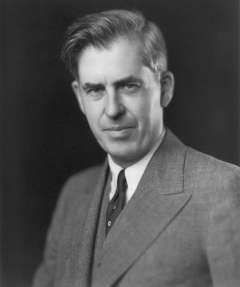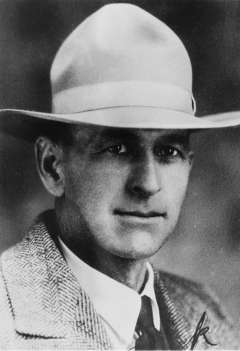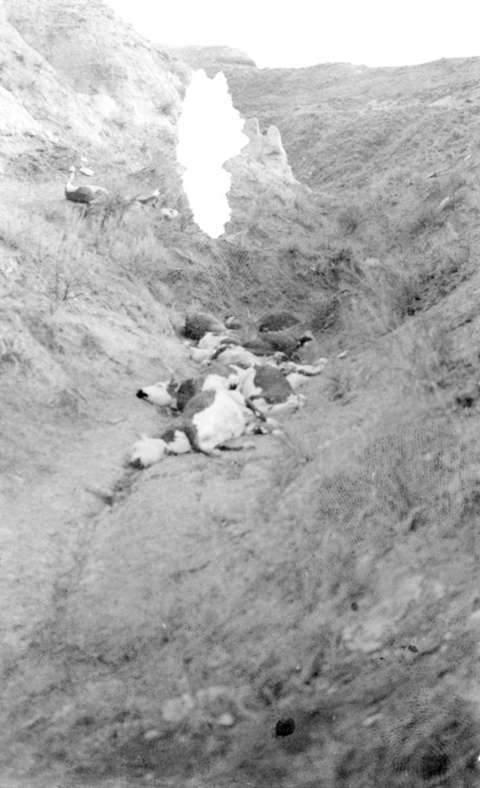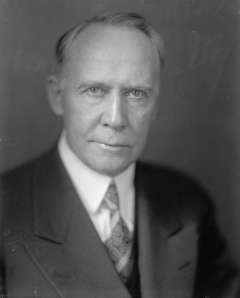- Home
- Encyclopedia
- Leasing The Public Range: The Taylor Grazing Ac...
Leasing the Public Range: The Taylor Grazing Act and the BLM
In Douglas, Wyo. in June 1934, according to historian Agnes Wright Spring, longtime Johnson County rancher Elmer Brock “rapped the butt of a six-shooter” on the podium when he called the annual meeting of the Wyoming Stock Growers Association to order.
The gesture was meant as a shot across the bow of the federal government; Brock was introducing the keynote speaker, U.S. Department of Agriculture Secretary Henry A. Wallace.


|
But Wallace, undeterred, responded with candor and bluntness, and, in language no one could misinterpret, spoke directly to the question of why the public range was in such sorry shape. He rebuked the livestock raisers for overstocking their ranges for the past five years, in some pastures to the point of erosion, possibly ruining the land permanently.
“It is all right,” he said, “to go ahead if you want to under your rugged individualism and overstock your ranges and eat off your good pastures, it is all right for you to hurt yourselves if you want to, but it is a shame to hurt the land the way you have been doing.”
As it happened, however, Wallace’s ideas about changing agriculture in the nation and especially in the West had preceded him before he spoke. Farmers and ranchers were worried. Five hundred turned out to hear the secretary’s address. Anticipation was high, the atmosphere was tense and, Spring says, “the air was charged with static.”
Henry Wallace was in his mid-forties. He would reach the peak of his political career in 1941, when he became vice-president of the United States. Historian John Franklin Carter described Wallace as a man “as earthy as the black loam of the corn belt, as gaunt and grim as a pioneer.”
Even the Wyoming ranchers and farmers who disagreed with him found Wallace honest and sincere. Historian Michael Cassity reports that Charles A. Myers of Evanston, president of the Wyoming Stock Growers, told his fellow ranchers in 1934 that Wallace was “working intelligently, honestly, earnestly, to overcome some of the troubles of the cowmen.”
The Taylor Grazing Act
Wallace’s remarks came just days before passage of the landmark Taylor Grazing Act. On June 28, 1934, President Franklin Roosevelt signed the measure into law. It was the first legislative action to organize grazing management on the public domain. By the time the legislation was enacted, according to Bureau of Land Management historian Marion Clawson, “a large part of the public lands had already suffered serious, accelerated erosion, largely (but not wholly) as a result of uncontrolled grazing.” The act resulted partly from mounting conflicts among livestock operators in the western United States, and partly from growing public recognition that, in many places, the rangelands had been severely overgrazed.
Background
Wyoming cattle and sheep raisers had been grazing their stock for free on public land since the 1860s. Custom, not law, determined who got to graze stock where on public land. The customs were based largely on a system of first come, first served: The ranchers who got to the ranges first, and filed land claims on small plots around water sources, ended up in control.
Conflicts over these customs led to the so-called Johnson County War of 1892, and after that, as millions of sheep were gradually introduced to Wyoming ranges, to a decade and a half of raids on sheep camps by cattlemen. Fifteen sheepmen and a boy and perhaps 10,000 sheep were killed. Successful prosecution of perpetrators after the Spring Creek Raid in 1909 finally put an end to the violence. Still, stock grazers of all stripes—sheepmen with large and small flocks and cattle ranchers with large and small herds—were economically insecure in an unregulated system.
All along, however, there had been talk of turning the unclaimed federal lands over to the states, or setting up some kind of leasing system or both. As early as 1879, Wyoming cattlemen rejected a proposal that would have allowed them to buy up land in large blocks at five cents per acre, or pay half a cent per acre for long-term leases, historian T.A. Larson notes. But since the grazing was free, they felt no incentive to look at any alternatives.
In 1897, Wyoming Gov. William Richards suggested to the Legislature that if the state could control the public range and lease it at low rates to grazers, overgrazing would be reduced, taxes would fall and range conflicts would end, Larson notes. That idea stalled, but under the conservation-minded Theodore Roosevelt administration in the following decade, the new federal forest reserves, ancestors of today’s national forests, instituted grazing leases.
At the same time the federal government began prosecuting some prominent stockmen in Wyoming and other states for fencing the public ranges. The practice had been illegal since 1885, but laws against it had been only sporadically enforced. Results were mixed. The few ranchers that were convicted in Wyoming were released after serving a day in jail. Still, it convinced many ranchers that leasing might be a good idea after all, and most of the illegal fences came down.
In 1907, the Wyoming Wool Growers’ Association passed a resolution strongly opposing any leasing of the public ranges. That is, there was no consensus about leasing among Wyoming—or western—stockraising interests.

Meanwhile, homesteading—the claiming, improving and finally the acquisition of full title to relatively small plots of federal land for farming or grazing—continued. In 1914, private land still made up only about 16 percent of the state. In 1916, Congress expanded the amount of land a person could claim to include a full square-mile grazing homestead. As a result, the amount of private land doubled in the 1920s in Wyoming as nearly 10 million acres passed from federal into private hands. Private land by the end of the decade made up about 40 percent of the state.
In 1926, Wyoming Congressman Charles A. Winter, a Republican, began pushing for transfer of federal lands in all the western states to those states, and spoke repeatedly on the subject in Congress and around Wyoming. In 1927, the Wyoming Legislature unanimously passed a resolution in favor of cession. In 1928, Winter ran for the Senate against Democrat John B. Kendrick, the incumbent, a longtime stockman who had first come up the trail from Texas in the 1880s. Kendrick opposed the cession idea, and won the election.
Still, the idea seemed to gain power. In 1929, President Herbert Hoover proposed ceding 190 million acres of federal grazing to the states, 17 million of those in Wyoming, but with the federal government retaining the mineral rights. He appointed a committee. After many hearings the panel proposed cession of grazing lands to states that would accept them, but with the federal government retaining mineral rights, and retaining also all federal forts, forests, parks, monuments, reservoirs and bird refuges.
Congress started work on a bill that included these provisions, and allowed the states to sell the land at $3 per acre and lease lands that weren’t sold. The proceeds would help fund education.
Still, the stock raising interests were unable to unite behind the proposal. Wyoming Wool Growers President Tom Cooper of Casper testified that $3 per acre was too high. Others, Senator Kendrick among them, said the mineral rights needed to be included as well. In 1933, Kendrick introduced a bill that would have included the mineral rights with the ceded land. It failed. Kendrick died soon afterward. Wyoming’s new senator, Joseph O’Mahoney, introduced a similar measure but it failed as well.
Meanwhile, Franklin Roosevelt was elected president in 1932, took office in March 1933 and immediately launched his New Deal proposals to a heavily Democratic Congress. National politics had shifted dramatically.
A new era
The new Taylor Grazing Act, passed in 1934, effectively ended homesteading; people could no longer claim public land for agriculture. The act also provided a mechanism for managing grazing on the public domain by giving the secretary of the Interior authority to classify public land according to the most productive use.
Once passed, the act met with mixed reviews from Wyoming livestock operators. Many attributed the range conditions to simply a couple of years of low rainfall. Some, like John Budd of Big Piney, testifying to Congress a few years later, insisted that the deplorable range conditions in the drought years before the act was passed were abnormal, and that when more normal amounts of rain fall, range quickly recovers.
According to stockmen, that is, the problems had natural causes and were not the result of overgrazing. And Larson, in a footnote, mentions historian James Malin, who felt the government exaggerated the effects of overgrazing in order to arouse the public sympathy needed to get the new law passed.
Still, many ranchers also acknowledged the results of overgrazing and the need for reforms. In a letter to George Ferrell, western division director for the Department of Agriculture, Natrona County rancher George Snodgrass noted that until just before enactment of the Taylor Act, most stockmen at the meetings he had attended said that the land was being seriously overgrazed and something had to be done about it, according to historian Mackey.
Many ranchers, especially large operators, supported the legislation because it put an end to homesteading. Clawson notes that large livestock operators, many of whom also had other lines of business, benefited from passage of the act.
Ultimately, the act brought order to the chaotic situation of competing livestock grazers using the public domain by asserting federal management and establishing a system of grazing rights and fees. In the process more than a million head of livestock were removed from the public lands.

More importantly, a 1939 amendment to the act provided for the establishment of district boards to give range managers advice on such matters as proper grazing, proper stocking rate and the practicality of proposing range improvements. This allowed strong local input into management of the range.
These boards were inevitably heavily influenced, if not controlled outright, by industry representatives who tended to own large cattle and/or sheep outfits. Wesley Calef observed that the Rock Springs Grazing Association was in a “strong position with respect to its Taylor grazing lease.” In that district, Calef noted, “The president of the association is also president of the Grazing Advisory Board of Wyoming District 4. Four of the six sheep ranchers’ representatives on the local advisory board are also shareholders in the association.”
Thus, the system was not altogether a government takeover of private prerogatives. More nearly it was a situation in which the most powerful and prominent bodies—the producer groups organized earlier—exercised power both on their own and in their newly acquired governmental authority, historian Cassity notes.
In 1946, the Federal Grazing Service and the General Land Office, which oversaw the grazing boards, were combined and became part of the new Bureau of Land Management. The modern BLM is the result of the Federal Land Policy and Management Act (FLPMA) enacted on Oct. 21, 1976, which consolidated the functions of several agencies. Under the terms of this act, professionally educated and trained federal range conservationists manage grazing for the BLM. Arguably the most important function of the BLM remains administration of livestock grazing on those federal lands not designated to other agencies like the U.S. Forest Service.
FLPMA incorporated a wide range of other management jurisdictions into the BLM including the Mineral Leasing Act and the National Trails System Act.
During the Clinton administration in the 1990s, the grazing boards were dissolved because they violated a new federal law that did away with a broad array of such special purpose advisory groups that influenced government without participation of the general public.
Today, private grazing on BLM lands in Wyoming is guided by more than 100 specialists in grazing, wildlife management and multiple-use staff. These specialists oversee 17 million acres of public lands administered by nearly 3,000 grazing permits and leases, according to the BLM’s 2014 annual report. Grazing issues are also part of local BLM jurisdiction planning processes, such as resource management plans, that are revised on a 10 to 20 year cycle.
BLM range management officials implemented more than $1 million per year of range improvement projects to facilitate efficient grazing for more than a decade leading up to 2014. That year, the BLM collected more than $1.8 million in grazing fees, and the state of Wyoming received more than $27 million from the BLM in lieu of taxes on federal lands.
Resources
- Calef, Wesley. Private Grazing and Public Lands: Studies of the Local Management of the Taylor Grazing Act. Chicago: The University of Chicago Press, 1960
- Carter, John Franklin, The New Dealers; New York: The Literary Guild 1934.
- Cassity, Michael. Wyoming Will Be Your New Home: Ranching, Farming and Homesteading in Wyoming: 1860-1960. Cheyenne, Wyo.: Wyoming State Historic Preservation Office, 2011, 249, 260, 261.
- Cawley, R. McGreggor. Federal Land Western Anger: The Sagebrush Rebellion and Environmental Politics. Lawrence, Kan.: University Press of Kansas, 1993.
- Clawson, Marion. The Bureau of Land Management. New York: Praeger Publishers, 1971, 86, 110.
- Larson, T.A. History of Wyoming. Lincoln: University of Nebraska Press, 1965. Larson does an excellent job tracing the social and political conflicts that led finally to passage of the Taylor Grazing Act. See pp. 365-372, 374-378, 380-385, 414-418, 426-431. The footnote on James Malin’s contention that the government exaggerated the effects of overgrazing in order to arouse sympathy for the Taylor Grazing Act is on p. 430.
- Mackey, Mike. Wyoming in the Twentieth-Century: Topics in the History of the Cowboy State. Sheridan, Wyo.: Western History Publications, 2011, 101, 174.
- “Henry A. Wallace.” Wikipedia. Accessed Aug. 13, 2015, at https://en.wikipedia.org/wiki/Henry_A._Wallace.
- Proulx, Annie, ed. Red Desert: History of a Place. Austin, Texas: University of Texas Press, 2008.
- Skillen, James R. The Nation’s Largest Landlord: The Bureau of Land Management in the American West. Lawrence, Kan.: University Press of Kansas, 2009.
- Spring, Agnes Wright. Seventy Years: a Panoramic History of the Wyoming Stock Growers Association, Cheyenne, Wyo.: Wyoming Stock Growers Association, 1942.
Illustrations
- The D.N. Townsend photo of Henry Wallace is from Wikipedia. Used with thanks.
- The photos of Elmer Brock and of the dead cattle on the O.W. Ranch—near the junction of Clear Creek and Buffalo Creek in Johnson County—are from the Wyoming State Archives. Used with permission and thanks.
- The photo of Congressman Charles Winter is from the Library of Congress. Used with thanks.
